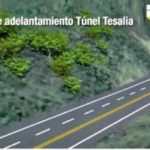Update: Hidroituango Crisis Likely Over by October 2018, Completion in 2021, If Challenges Overcome

In a June 20 press conference, Medellin-based multinational electric power giant EPM announced that it now foresees the likelihood of overcoming the current engineering crisis at its US$5 billion, 2.4-gigawatt “Hidroituango” hydroelectric project in Antioquia by around October 2018.
What’s more, EPM revealed in a separate filing June 18 that Hidroituango construction would be completed by around 2021 — possibly a year later than initially planned — assuming that current engineering and geology challenges facing the dam and tunnel works are overcome.
EPM general manager Jorge Londoño de la Cuesta explained that thanks to falling water levels in the Cauca River, EPM probably can move in the next months to close permanently the right diversion tunnel that had collapsed and burst last month, forcing EPM to redirect Cauca River waters temporarily through the dam’s machine house.
Since EPM is likely to have completed raising and reinforcing the dam to at least 418 meters above sea level over the coming weeks, it’s now become possible to forecast closing another crucial tunnel — that is, the tunnel to the machine room — hence enabling Cauca River waters to flow safely over the engineered spillway at 401 meters above sea level, rather than through problematic tunnels.
Bottom line: The currently evacutated downstream populations in Puerto Valdivia could return to their homes, probably around October — meaning the crisis is nearly over.
In the filing (see: https://www.superfinanciera.gov.co/publicacion/informacion-relevante-61446, listing under “Empresas Publicas de Medellin ESP,”), EPM points out that “until today [June 18] the technical information available allows us to estimate that the main structures of the Ituango hydroelectric project — dam, landfill and powerhouse — have not been significantly affected, so the completion of the project is considered viable, which we believe could be carried out within an estimated period of three years. But there is still uncertainty due to the fact that several of the activities necessary to achieve this objective are in the process of definition and design.”
According to the filing, EPM is working with “specialists, contractors and a panel of national and international experts in regaining control of the project with actions that include reaching the 418 [meters above sea level] of the dam, plugging the right [Cauca River water] diversion tunnel, covering the auxiliary diversion system and closing the flow of water through machine house.
“In this process, the company has been accompanied by world authorities in fields of knowledge such as: construction aspects, hydraulics, geology, geotechnics, risk management and emergency response,” according to the filing.
Despite the current challenges, EPM so far this year has delivered earnings before interest, taxes, depreciation and amortization (EBITDA) of COP$1.7 trillion (US$580 million), up 10% year-on-year, according to the filing. EPM is 100% owned by the city of Medellin, which gets about 25% of its annual revenues from the utility.
What’s more, the company expects that full-year 2018 EBITDA will come-in at around COP$5 billion (US$1.7 billion), according to EPM.
In addition, EPM can tap US$1.3 billion in credit lines from major international financiers including the Inter-American Development Bank, IDB Invest, CAF and BNDES, according to the company.
Furthermore, EPM has decided to cut 2018 expenditures by around COP$300 billion (US$102 million) in order to help offset future losses expected by delays in electricity sales from Hidroituango, as well as to cover associated extra costs for food, shelter, water, sanitation, utilities, transport, health-care and new infrastructure for affected downstream populations during the temporary crisis.
What’s more, the company has identified a further COP$2 trillion (US$681 million) in possible postponements of planned investments, in order to compensate for future delays in earnings from Hidroituango, according to the filing.
If necessary, EPM also could tap sales of certain assets from its COP$48 trillion [US$16 billion] portfolio, including assets in affiliates worth more than COP$9 trillion (US$3 billion), according to the company.
Thanks to continuing construction of the dam – now at 415 meters above sea level — and with the engineered spillway now complete, the dam could withstand a Cauca River flood-flow of 6,000 meters per second, a rate that is calculated to occur about once every 500 years, according to the company.
“In this priority landfill [that is, the accelerated raising of the dam-height to 415 meters], the same materials were also used in the construction of the [pre-emergency dam works] up until the moment of the [diversion-tunnel collapse and later tunnel rupture] on April 28, when the dam elevation was 385.8 meters above sea level. These materials comply with national and international standards in terms of impermeability, filters and transitions for this type of works,” according to the filing.
“After reaching the [current] level 415 meters above sea level, the works are now focused on raising the dam to 418 meters above sea level and reinforcing the priority landfill. This with the purpose of turning [the priority section landfill] into a definitive dam for the project and reaching a final elevation of 435 meters above sea level.
“To have greater control over any contingency, a monitoring center was established that operates seven days a week, 24 hours a day, 365 days a year, where it is possible to observe that for [the last] 10 days the behavior of the monitored indicators (flow, dam and landslides) show a normal and stable performance,” EPM added.
Beyond all these financial and engineering safety measures, EPM also has a US$2.55 billion insurance policy covering infrastructure and equipment damage (with a US$1 million deductible), and a loss-of-electricity-sales policy (because of delays in entry-into-operations beyond 90 days) of US$628 million, the company added.
That policy is underwritten by global insurance giant Maxseguros, while EPM’s own (proprietary) insurance company isn’t affected, according to the company.
















